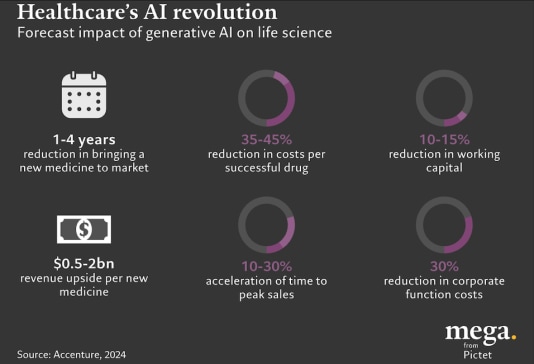Technology is ushering in a new generation of healthcare, supported by specialised tools that can help speed up drug discovery and treatments.
Once, the world dreamed of having a pill for every ill. Today, next generation therapies are changing our perspective, making it possible to alter our genes and our cells, to engineer antibodies and to personalise medicine to a degree that was unimaginable even a decade ago.
Next generation therapies are becoming increasingly safe and efficient, which in turn is making them more popular, according to the members of the Thematic Advisory Board for our Health strategy. However the discovery, development and manufacture of these headline-grabbing therapies are only possible with the help of a much less known sector – next generation tools.
Diagnostics, for example, are being revolutionised by the advent of universal biosensors. Sometimes dubbed “liquid brains”, these can identify a wide range of proteins, nucleic acids, pathogens and small molecules, enabling them to detect pathogens, monitor the spread of chronic diseases and assess drug levels.When it comes to manufacture of next gen therapies, meanwhile, tools include specialised bioreactors – which offer a highly controlled environment for cultivating cells or micro-organisms – and specialised filtration equipment that can remove viruses and other potentially harmful contaminants from the final product.Then there are the tools that are aimed at automating the development of next gen therapies, and the process software and AI tools that facilitate it.
Next generation tools have already achieved a dramatic expansion in the volume of therapies, significantly speeding up manufacturing time, as well as reducing costs and resources required. Reducing the need for labour can be particularly valuable, given that labour accounts for some 50-70% of cell and gene therapies’ manufacturing costs.
 |
To give just one example of possible benefits, a ground-breaking tool from Thermo Fisher Scientific replaces traditional depth filtration with single-use centrifugation. The new system requires fewer disposable filters, which means less cleaning and sterilisation (saving energy and cutting water use), less labour and lower overall costs. It has already been used in the manufacture of monoclonal antibodies – lab-produced molecules which are designed to bind to specific targets such as virus or cancer cells, and then neutralise them or flag them up for distruction by the immune system. Using the single-use centrifuge system, the manufacturing process used 45% less water than previously, as well as saving money and speeding up time-to-market.
Next gen tools are being embraced by contract development and manufacturing organisations, or CDMOs. These specialised service providers focus on specific areas of drug development and manufacturing, taking on these responsibilities from the pharma sector. CDMOs add value by streamlining the research and manufacturing process across the industry – often leading the way with new technologies, including AI.
Many of these tools have other applications too. Universal biosensors can monitor environmental data such as pollutants in the air, water or soil, or used to test food safety.
With continued development of advanced therapies – such as bispecific antibodies, gene therapies, and nucleic acid-based treatments – we will need continued improvement in the cost, time and complexity of their manufacture. This creates an interesting growth opportunity for companies in the next gen tools segment, and for those who have the expertise to invest in them. Such advances in turn should drive further growth across pharma and biotech.
Investment insights by Moritz Dullinger, Senior Investment Manager, Thematic Equities, Pictet Asset Management and Gregoire Biollaz, Senior Investment Manager, Thematic Equities, Pictet Asset Management
- With a medium- to long-term perspective, we believe the health sector is poised for strong performance due to several key factors. The aging global population is driving an increase in age-related diseases, making it essential to keep people healthier for longer to control healthcare costs.
- Scientific advancements are improving care standards, but rising healthcare costs due to inefficiencies highlight the need for disruptive technologies that enhance both care and efficiency. Additionally, as wealth grows, so does the focus on health, with consumers investing in personal care and healthier lifestyles. Governments are also promoting preventive health measures through incentives and regulations.
- Companies that provide products and services to maintain and improve health stand to benefit from this long-term trend.




